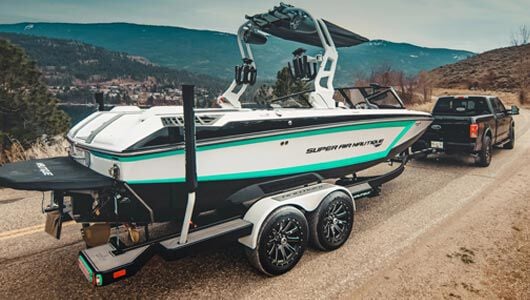Riding on the right trailer tires

The campsite’s booked, the weather looks promising, and you’ve even got big plans to beat the weekend highway traffic—but have you given any thought to the RV or trailer tires that will get your weekend-home-on-wheels to your favourite spot?
Ensuring you have the right RV tires or trailer tires helps ensure smooth sailing all the way to the campground.
In this guide, we’ll walk you through some helpful hints to make sure you’ve got the right tires, pressure and load so your RV or trailer delivers optimum performance and safety.
Why are special trailer (ST) tires best for Trailer and RV's?
Special trailer (ST) tires are designed for:
- RV’s
- Trailers, including fifth wheels and tent trailers
- Boat trailers
- Utility trailers
Some RV owners decide to install light truck (LT) tires on their RV’s; however, like other passenger vehicle tires, LT tires typically have more flexible sidewalls that can lead to trailer sway and handling issues while driving. ST tires, on the other hand, tend to be stiffer and narrower, which allows for:
- Better sway reduction
- Increased towing stability
- Cooler tires while driving (increases life span)
How do you know what size RV tires or trailer tires you need?
There’s a good chance you’ll find in the owner’s manual all of the information you need for selecting tires that fit your vehicle and your weight support needs. Most RV’s will also have a door placard listing tire information. Both should contain recommendations for tires according to:
- Size
- Gross vehicle weight rating (GVWR) (the maximum weight the vehicle can carry fully loaded)
- Gross axle weight rating (the maximum weight each axle can bear)
- Load rating
- Recommended pressure
Knowing these weight ratings and specifications will help you choose appropriate tires that meet the manufacturer’s recommendations—helping you enjoy longer tire lifespan as well as improved safety and handling.
It’s also important to ensure the wheel you are installing on a tire is DOT (department of transportation) compatible for weight, and is also DOT stamped to help avoid tire and wheel failure.
What's the difference between radial and bias ply RV tires and trailer tires?
You’ll be able to find out whether your RV is outfitted with bias or radial tires by looking on the sidewall. Just below the tire size, you’ll see the word ‘radial’ or ‘bias.’ If it says ‘radial,’ you’re in luck because they’re built to withstand Canada’s rugged outdoors.
Radial tires

Radial tires, sometimes referred to as ‘radial-ply’ tires, are constructed using a combination of polyester and/or nylon plies that run straight across the tire, from bead to bead.
Advantages:
- Better stability & comfort on uneven roads. On radial tires, the sidewall and tread act independently of one another. As a result, sidewall flex isn’t transmitted to the tread, which is a good thing. It allows the vehicle to transfer more power to the ground for improved handling.
- Greater availability in Canada and the US. In the event that tire trouble waylays you while you’re cruising south to your winter home in Phoenix or Florida, you won’t be sidelined for long.
Bias tires

With bias-ply tires, the polyester and/or nylon plies run diagonally across the tire, overlapping in a crisscross pattern.
Advantages:
- Tougher sidewalls offer durable off-road hauling
Disadvantages:
- Greater impact and vibrations from bumps and gravel roads. On a bias-ply tire, the overlapping plies tend to be thicker and less flexible. The crisscross ply configuration also causes the tread and sidewall to be interdependent. So, when the sidewall flexes, so does the tread. This affects its ability to maintain optimal contact with the road surface. For RV-ers who drive on gravel roads in Canada, that’s not welcome news.
- No availability in Canada. Bias ply tires are not readily available in tire shops north of the border. So, if you get a flat and need to replace a bias-ply tire somewhere along your journey, you’ll probably have to wait several days to have a replacement shipped up from the US. Canadians are sometimes surprised to learn their RV’s are outfitted with bias-ply tires.
Check your pressure before - and during - road trips
It’s essential that you properly inflate your trailer tires to the pressure recommended in your owner’s manual or door placard.
For consistent and accurate tire pressure readings, it’s best to check them when they’re cool (i.e. in the morning before you start driving). Some RV owners intentionally reduce their tire pressure for a ‘smoother’ ride, but don’t fall into that trap as it reduces a tire’s load-bearing capacity, which can lead to poor handling, traction and braking. It also increases the likelihood of tire failure.





